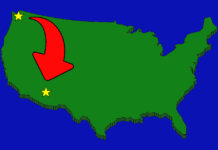It’s as pure as it’s ever been. It’s addictive. The State of Arizona has been dealing with it for 10 years, and it’s on the radar as a growing national problem. “It” is crystal methamphetamine (meth) – the most prevalent illegal drug in use today.
Cindy Schaider, Coordinator for the Casa Grande Alliance, appeared before the members of the Public Safety Advisory Committee last week to ask if they thought drug abuse and underage drinking was problematic in Maricopa.

Cindy Schaider, Casa Grande Alliance Coordinator, presented the proposal for a Maricopa Drug Prevention Coalition.
According to Schaider, the 35 individuals and agencies who are part of the Casa Grande Alliance, formed in 1989, work together to prevent substance abuse and violence there. The city has approved a pseudoephedrine ordinance, regulating the sale of over-the-counter drugs like Sudafed and Sinutab, which are boiled down and added to toxic chemicals to create meth.
“In Casa Grande,” Schaider stated, “eighth grade meth use is 250 times higher than it is statewide.” Schaider added that Hidden Valley is a known locale for meth use.
Casa Grande’s coalition joins five others, located in Eloy, Coolidge, San Manuel, Superior and Hayden, all of which have been funded by grants. Schaider hopes to establish two other coalitions – one in Apache Junction and the other here in Maricopa.
A Maricopa Drug Prevention Coalition would be part of a county wide anti-meth initiative, funded by the Pinal County Sheriff’s Office and hosted by the Casa Grande Alliance. Its purpose would be to provide awareness, education and prevention of methamphetamine in this community.
Such a coalition would be community rather than government based; it could be either non-profit or have a fiscal agent. Vice-Mayor Brent Murphree suggested obtaining a proclamation and an endorsement from city government as well as publicizing the coalition. “We need to get the information out there,” noted Murphree.
Schaider would mentor the Maricopa coalition for a few months. She plans a half-day summit in April or May where all eight coalitions would increase their knowledge of meth issues and create action plans for meth prevention, treatment and enforcement. The plans will be forwarded to the Governor’s office for funding purposes.
Murphree, the chairman of the Public Safety committee, and board members Joe Trujillo and Carl Diedrich are forming a committee for the coalition and, ultimately, its membership. Trujillo and Diedrich are also working to make Maricopa a member of the Drug-Free Communities Support Program, which provides grants of up to $100,000 to community coalitions that mobilize to reduce substance abuse among youth and to strengthen community collaboration.
Funding sources like the Drug-Free Communities Program enables coalitions to strengthen their coordination and prevention efforts. Coalitions are based on the belief that only by working together can a safe and drug-free community be created.

![‘Flying Bucket Fire’ doubles size, causes $200K in damage Tucson's Northwest Fire District crew members assist in firefighting efforts on the "Flying Bucket Fire" approximately 15 miles southwest of Maricopa on May 8, 2024. [Northwest Fire District]](https://www.inmaricopa.com/wp-content/uploads/2024/05/northwest-fire-district-050824-flying-bucket-fire-01-218x150.jpg)
![GAME OVER: The city government tried to get into gaming. It failed Maricopa Esports [Victor Moreno]](https://www.inmaricopa.com/wp-content/uploads/2024/05/263342f5-13e7-4668-838c-f574392086fb-218x150.jpg)



![Rizz party organizers say city ‘lying’ One of several flyers for a "TikTok rizz party" is taped to a door in the Maricopa Business Center along Honeycutt Road on April 23, 2024. [Monica D. Spencer]](https://www.inmaricopa.com/wp-content/uploads/2024/04/spencer-042324-tiktok-rizz-party-flyer-web-218x150.jpg)
![Province writer opens the athlete’s mind in new book Tom Schuman, a Province resident, poses with a copy of his new book, "My Wide World of Sports," outside his home on May 2, 2024. [Monica D. Spencer]](https://www.inmaricopa.com/wp-content/uploads/2024/05/spencer-050224-tom-schuman-sports-book-web-01-218x150.jpg)







![Wildfire cause confirmed, investigation underway: State Tucson's Northwest Fire District crew members assist in firefighting efforts on the "Flying Bucket Fire" approximately 15 miles southwest of Maricopa on May 8, 2024. [Northwest Fire District]](https://www.inmaricopa.com/wp-content/uploads/2024/05/GNEq06pbwAA6JlT-100x70.jpg)

